italiaDesign

italiaDesign / 2016
~ in-field research, branding, videography, ux design, copywriting
~ in-field research, branding, videography, ux design, copywriting
A website showcasing interviews and photos taken during a two-month Italian Design field study inspired by Italian history, art, culture, architecture, and design.
︎ Visit the site
︎ Visit the site
About
ItaliaDesign is a 7-week long intensive undergraduate field study and research program with a focus on documenting Italy’s rich design culture. The study was conducted across Italy, from Florence to Milan, as well as in 2 cities in North America. As a part of the program, our team conducted and produced studio interviews on design and developed a website to document our experience and findings. We spoke with 19 prominent and emerging designers in the industry such as Mario Trimarchi, Massimiliano Fuksas, and Moleskine. Our team distilled these findings down into 70 short films for the global design community. I was a part of Gruppo Dieci, the tenth group of senior design students to take part in this adventure.
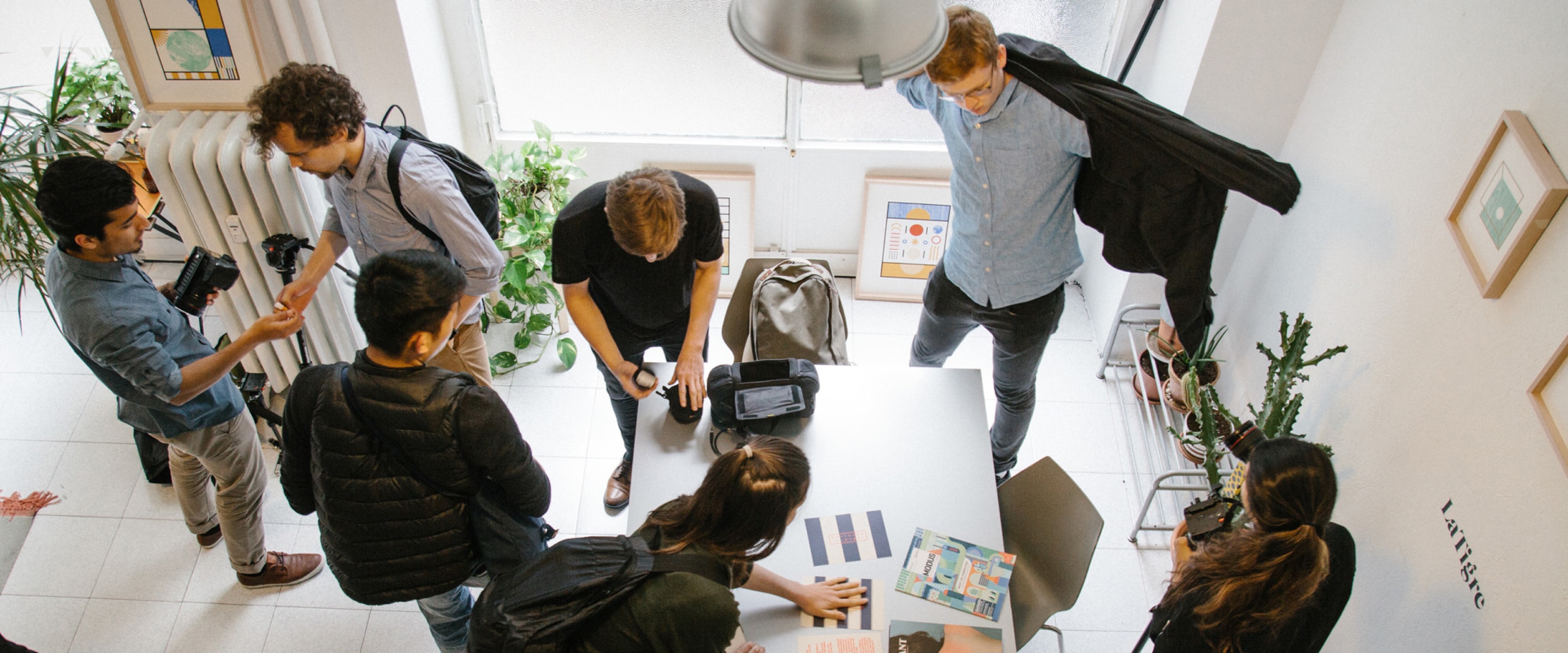
Exploration through layers
Much like the layers of history in contemporary Rome, italiaDesign 2016 was built on 10 years of past italiaDesign groups' research and insights. Being the 10th anniversary of italiaDesign, we took this concept and brought it into the brand and website we developed and created.
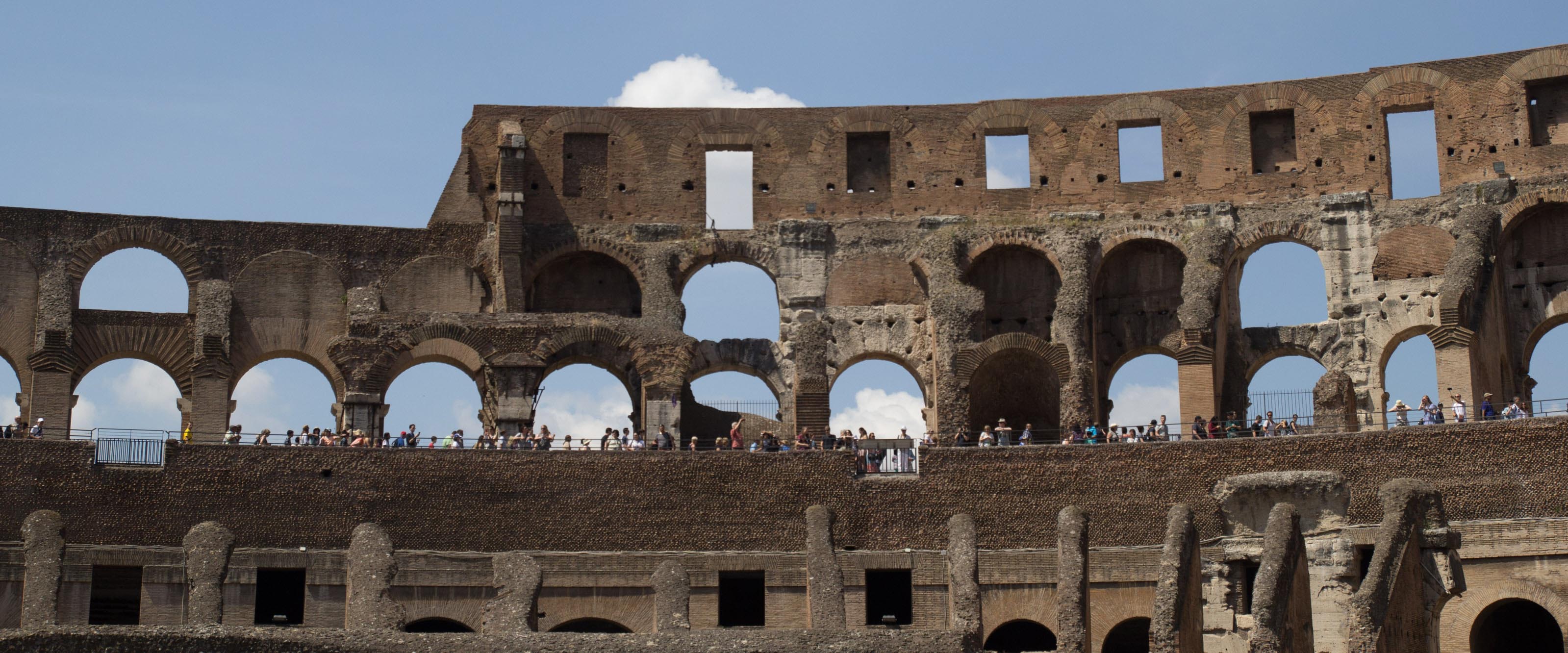
Cheerful & Curious
We decided to create a brand that was young and lively, representing our group and us as designers. By creating colour overlays, we could further demonstrate the concept of layering. Each element acting as a block stacked ontop of one another. We paired a sans-serif typeface with the use of shapes to help portray this voice.
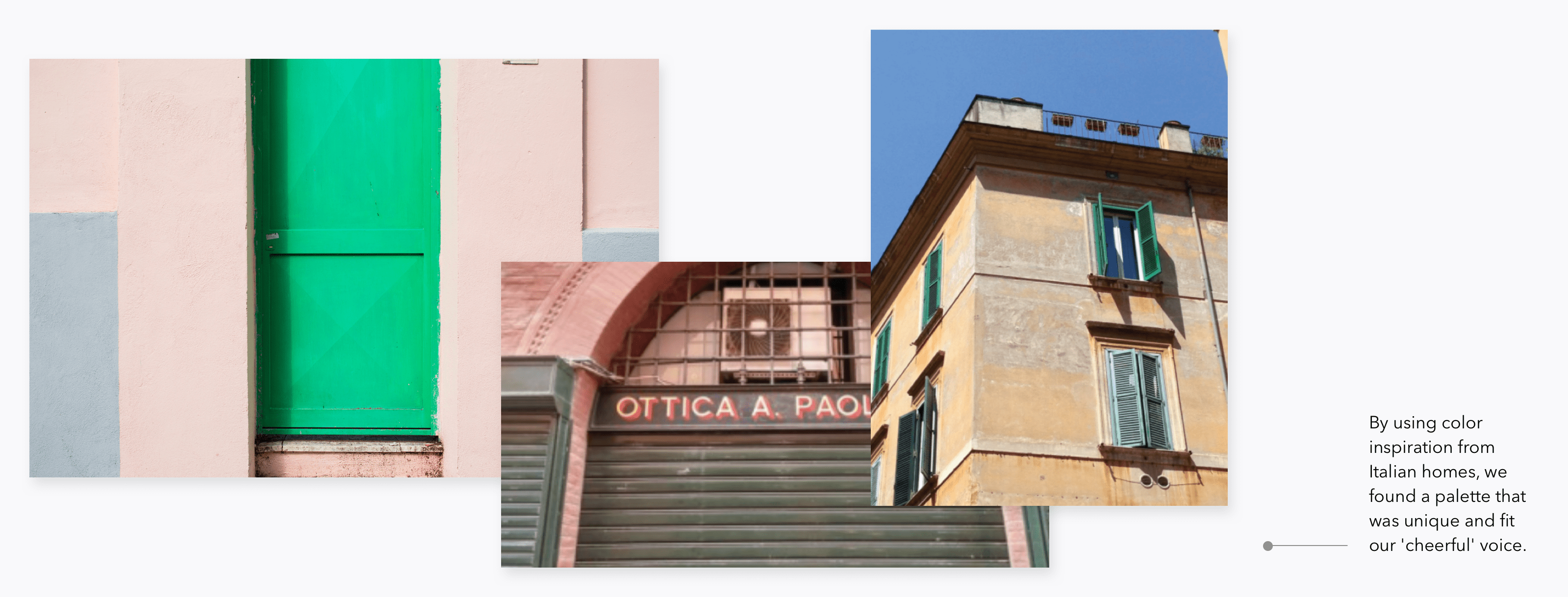
Patterns & Shapes
Using the word Dieci, our group’s name and meaning 10 in Italian, we were able to create block elements to build patterns and shapes relevant to Italy.
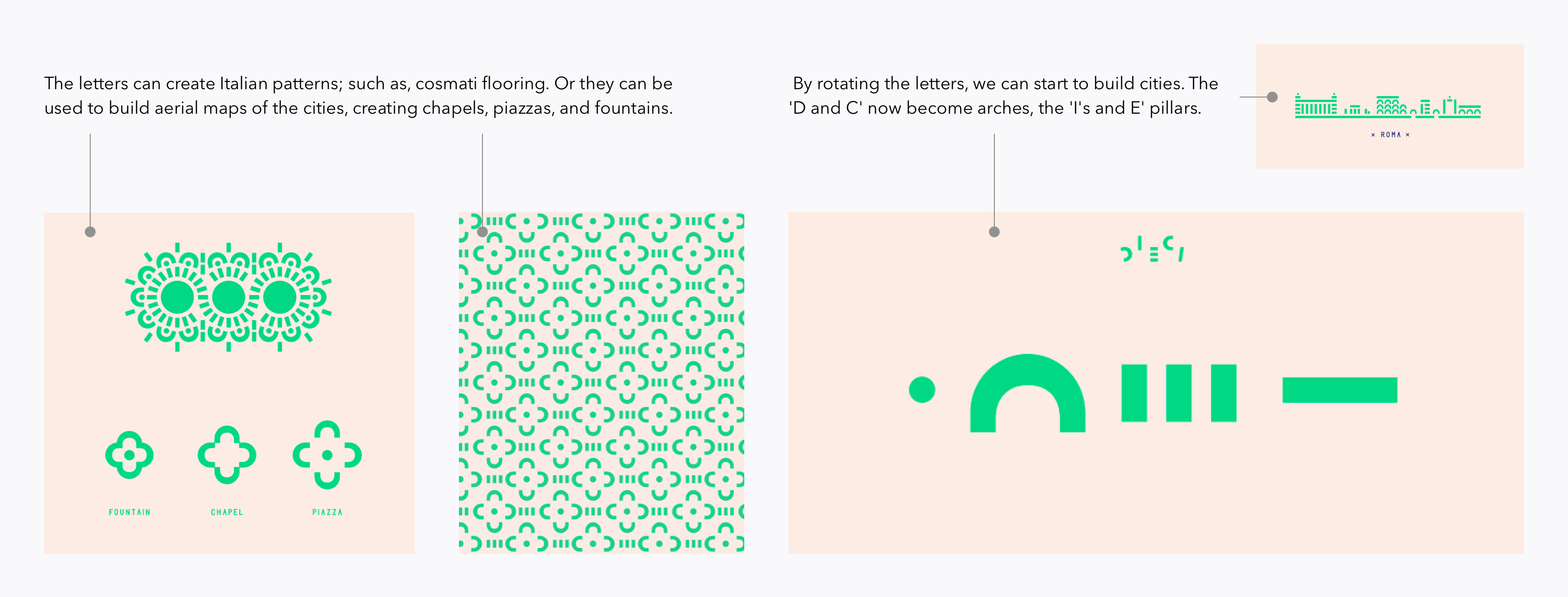
Discovery & Navigation
Going against typical navigation conventions, our content is physical built on top of one another, with the action of scrolling to reveal new content.
With scrolling as the key way to navigate around, viewers can move back and forth between content blocks (layers) quickly, and navigate smoothly.
Users are handed pops of discovery, delighted with content that showcases photography and quotes from our experience. Our focus was to get viewers to feel as though they are digging deeper into our site and exploring the layers of content like one does walking the streets of Rome.
With scrolling as the key way to navigate around, viewers can move back and forth between content blocks (layers) quickly, and navigate smoothly.
Users are handed pops of discovery, delighted with content that showcases photography and quotes from our experience. Our focus was to get viewers to feel as though they are digging deeper into our site and exploring the layers of content like one does walking the streets of Rome.

Films page
Building on top of the past to create a stronger future.
To celebrate ten years of italiaDesign, we also included some of the most informative and engaging work done by previous italiaDesign cohorts, as well as work from the sister program, dutchDesign.
By scrolling through the films page, viewers can see that there’s a lot to learn from the past. Each year, the field study offers the same program opportunity resulting in very different experiences to share. It was important for us to take a moment and showcase this content.
Since italiaDesign revolves around interviews in the form of film, the films page became the epicentre of content. The page features each designer we interviewed as blue cards, and the larger collaborative films/cultural films as green cards. They live in parallax to each other on separate planes to create further layering.
︎ Visit films page
To celebrate ten years of italiaDesign, we also included some of the most informative and engaging work done by previous italiaDesign cohorts, as well as work from the sister program, dutchDesign.
By scrolling through the films page, viewers can see that there’s a lot to learn from the past. Each year, the field study offers the same program opportunity resulting in very different experiences to share. It was important for us to take a moment and showcase this content.
Since italiaDesign revolves around interviews in the form of film, the films page became the epicentre of content. The page features each designer we interviewed as blue cards, and the larger collaborative films/cultural films as green cards. They live in parallax to each other on separate planes to create further layering.
︎ Visit films page

Search
The search feature for the films page was an opportunity for a useful and unique experience for visitors. The prompt for searching is placed in the left hand corner ‘type to search’ and to search anything on the page, users can start typing and the search takes over the films page to reveal results.

Interviews
I had the opportunity to co-lead interviews for executive director Fabio Sergio (frog design), creative director Benjamin Williams (r/ga), architect and maker Omer Arbel (bocci design), and designer Federico Ferretti (continuum).
︎ Watch an overview from interviews
︎ Watch an overview from interviews

"What we should be making now are things that could gain in value over time, not lose value."
- Omer Arbel, Bocci
Prior to our interviews in Italy, we conducted 3 interviews in Portland, and 3 interviews in Vancouver. One of the Vancouver interviews was with architect and maker, Omer Arbel. He spoke about the importance of sustainability in design, not necessarily with the use of sustainable materials, but by producing products that are loved by their owners for years and years. When designing a product, Arbel asks himself, "if I make this object, will it be here 500 years from now?" He spoke about how if an object is beautiful enough, and if it has enough cultural emotional value to it, then it will never be thrown out. Its value is then enormous from a sustainability perspective.
︎ Watch video
︎ Watch video

"It's not about what you make, it's actually why you make it."
- Fabio Sergio, frog design
- Fabio Sergio, frog design
Interviewing frog design in Milano was quite an insightful experience. What differentiates frog from some other agencies is that they focus on getting into touch with the real end-users of their products and services that they design together with their clients. Instead of designing for the client, they design with the client. This way they get a better understanding of the needs of the communities they are helping rather than designing a product without fully understanding the use case for the end-users.
︎ Watch video
︎ Watch video

Sharing
The videos and website were shared amongst the design communities in both Vancouver and Italy. The feedback has been overwhelmingly positive, with over 1000 views on some videos, and multiple shares on social media.
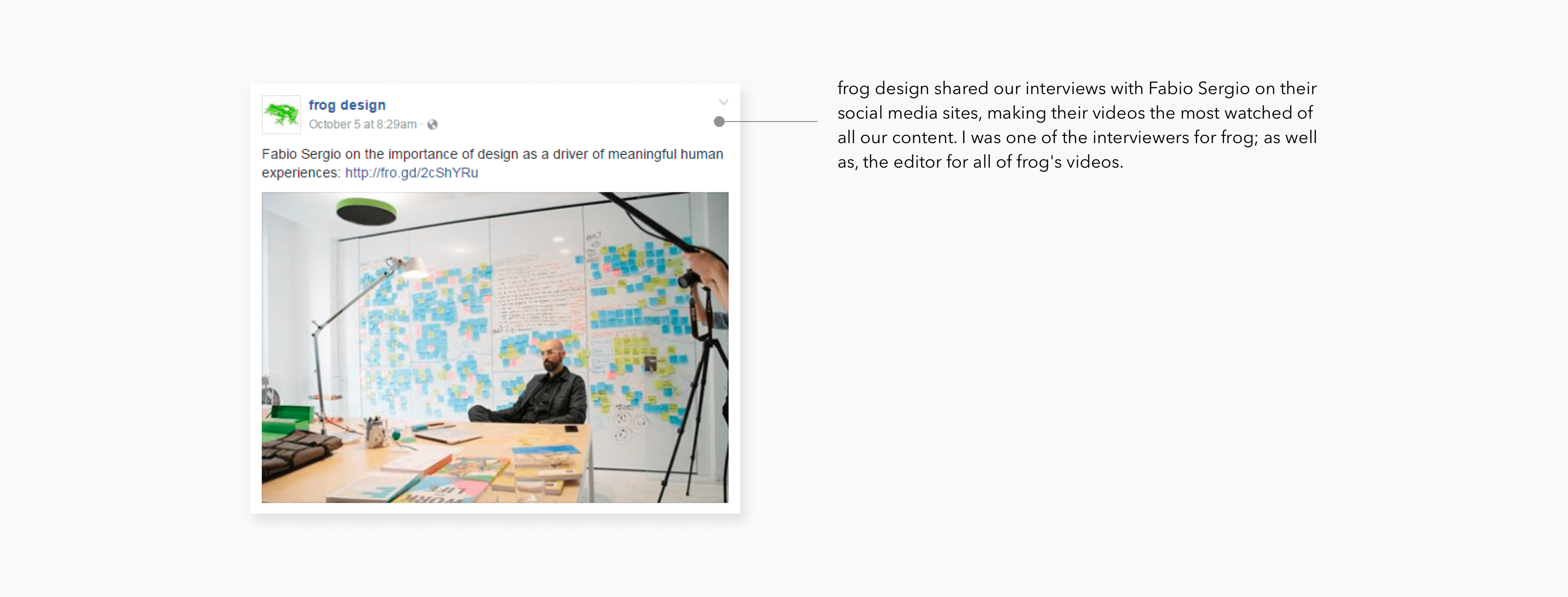
Reflection
italiaDesign became a huge learning experience for me.
Experiencing a new culture and speaking to role models in the industry brought me to understand more about the field of design and what makes a designer a designer. This field school has given me the ability to shift gears when necessary and truly be in the 'moment'. I never would have learned how to ‘really’ observe a city, a street, or a corner if it weren't for the valuable lessons I was taught in field. Now I feel I am able to look for the unexciting, the unobvious, the extraordinary in the ordinary and see that design is based on culture and people first.
Experiencing a new culture and speaking to role models in the industry brought me to understand more about the field of design and what makes a designer a designer. This field school has given me the ability to shift gears when necessary and truly be in the 'moment'. I never would have learned how to ‘really’ observe a city, a street, or a corner if it weren't for the valuable lessons I was taught in field. Now I feel I am able to look for the unexciting, the unobvious, the extraordinary in the ordinary and see that design is based on culture and people first.